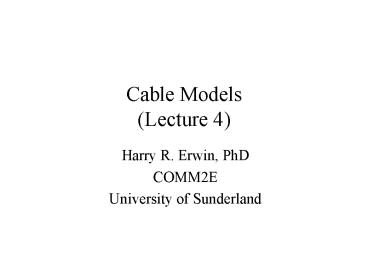Cable Models (Lecture 4) PowerPoint PPT Presentation
1 / 13
Title: Cable Models (Lecture 4)
1
Cable Models(Lecture 4)
- Harry R. Erwin, PhD
- COMM2E
- University of Sunderland
2
Resources
- Bower and Beeman, The Book of Genesis, 2nd
edition, available from http//www.genesis-sim.org
/. The user ID is babel and password is babelon. - Nicholls, Martin, Wallace, and Fuchs, 2001, From
Neuron to Brain, 4rd edition, Sinauer. (Good for
references, unless otherwise indicated, the
primary reference for this lecture) - Kandel, Schwartz, and Jessell, 2000, Principles
of Neural Science, 4th edition, McGraw Hill. - Dowling, 1992, Neurons and Networks, Belknap
Harvard.
3
The Question
- How do inputs to the neuron affect the potential
in the soma? - This involves the transfer of signals through the
dendritic tree. - Two primary models
- Passive transmission
- Active transmission
- The branching of the tree also matters.
4
Dendritic Trees
- Purkinje cells typically have one tree and 400
terminal tips. - ?-motoneurons from cat have 8-12 trees, each with
about 30 terminal tips - Dendritic diameters are a few ?m to less than 1
as they branch. - Spines on principal cells are of 0.1 ?m diameter
and 1 ?m in length. They seem to play a role in
plasticity. - Length 100-200 ?m up to 1-2 mm for motoneurons.
Total length can reach 1 cm and more.
5
Area and Volume
- Surface area on the order of 2000-750000 ?m2
- Volume up to 30,000 ?m3
6
Physiology
- Membrane resistance is typically much greater
than axial resistance. - The membrane usually functions as a capacitor.
- Time constants of 1-100 msec.
- Input resistance (Rin) can range between 1 and
1000 M?, which results in a small conductance
change of 1 nS can produce local membrane
potential changes on the order of tens of mV. - This can also trigger active conductances.
7
Conductance changes and time constants
- Fast synapses have inputs on a time scale of 1
msec and peak conductances 1 nS. - Slower synapses have longer time scales and lower
peak conductances.
8
One-dimensional cable equation
- Classical cable theory
- Assumptions
- Only considers length and time, not diameter
- Membrane is passive and uniform
- Core conductor has a fixed diameter
- Intracellular fluid produces a resistance
- Extracellular fluid is grounded
- Inputs are currents (linear)
9
Ralls analysis
- Flow along the dendrite
- 1/ri?V/?x -Ii
- Flow across the membrane
- ?Ii/?x -im-(V/rmcm?V/?t)
- Combining these, we get
- 1/ri?2V/?x2 cm?V/?tV/rm
- These are the actual values. Specific values are
designated by M subscripts rather than m.
10
The cable equation
- Solved completely by Rall (1959, 1989) and Jack,
Noble, and Tsien (1975) - Included branching trees
- In steady-state, you get exponential attenuation
with distance. - If the end is sealed, you get slower attenuation.
- If the end is clamped to rest, you get faster.
11
Space and membrane time constants
- The space constant is the distance over which the
membrane potential difference is attenuated by e.
This is the square root of the ratio of rm
(membrane resistance) to ri (axial resistance).
rinput sqrt(rmri)/2. Note rinput varies
inversely with the 1.5 power of the cylinder
radius, which is why the squid axon is so big. - The membrane time constant is the time over which
the membrane potential is also attenuated by e.
This is proportional to the produce of resistance
and capacitance. - These characterise how synaptic inputs are
integrated over a dendritic tree, by defining the
spatial and time windows over which inputs can be
combined.
12
Input resistance Rinput
- When a steady current I0 is injected into a cell,
you get a steady voltage on the membrane nearby,
V0. - V0/I0 is the input resistance.
- It measures the responsiveness of the region to
synaptic input. - This was used to develop a model for how
branching should be handled.
13
Myelinated neurons and saltatory conduction
- Myelin limits where ions can escape to the nodes
of Ranvier. This greatly increases the conduction
velocity along some large axons (up to 100 m/sec,
200 in some shrimp).

